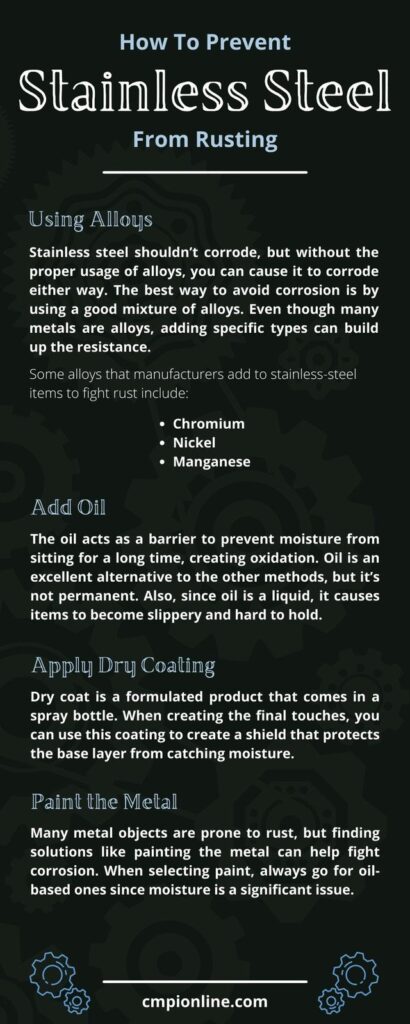
Stainless steel is renowned for its durability and resistance to corrosion, making it a popular choice for various applications. Its ability to withstand the elements, particularly water, stems from its inherent composition. However, despite its reputation, can stainless steel rust in water? While generally resistant, certain factors can compromise its protective barrier and lead to rust formation. This article delves into the causes of stainless steel rust, explores the role of chromium oxide layer, examines the impact of chloride concentration, and provides practical tips for preventing and maintaining stainless steel against rust.
This comprehensive guide will equip you with the knowledge to understand the intricacies of stainless steel corrosion and empower you to take proactive measures to preserve its longevity and aesthetic appeal.
Stainless Steel Rust Causes
Rust formation on stainless steel, while less common than on other metals, can occur due to a combination of factors. Primarily, it arises from a breakdown in the protective oxide layer that naturally forms on the surface of stainless steel. This layer, composed primarily of chromium oxide, acts as a barrier against corrosive elements present in water and air.
Several environmental conditions can weaken this protective layer, making stainless steel susceptible to rust. Exposure to harsh chemicals, acidic environments, or prolonged contact with saltwater can significantly accelerate corrosion. Additionally, mechanical damage to the surface, such as scratches or dents, can expose the underlying metal to corrosive agents, increasing the risk of rust formation.
Chromium Oxide Layer

The chromium oxide layer is a crucial factor in determining the corrosion resistance of stainless steel. This passive layer forms spontaneously when stainless steel comes into contact with oxygen, creating a thin, transparent film that effectively shields the underlying metal from further oxidation. The chromium content in stainless steel directly influences the thickness and stability of this protective layer.
Higher chromium content generally results in a thicker and more robust oxide layer, enhancing the metal’s resistance to corrosion. Conversely, lower chromium levels can lead to a thinner and less effective barrier, making the stainless steel more vulnerable to rust formation.
Factors Affecting Chromium Oxide Layer
Several factors can influence the integrity of the chromium oxide layer:
- Temperature: Elevated temperatures can weaken the oxide layer, increasing susceptibility to corrosion.
- pH Level: Acidic environments can dissolve the protective layer, exposing the underlying metal to corrosive agents.
- Presence of Chlorides: Chloride ions are highly corrosive and can penetrate the oxide layer, accelerating rust formation.
Chloride Concentration and Corrosion
Chloride ions play a significant role in promoting corrosion on stainless steel. These negatively charged ions readily attack the chromium oxide layer, disrupting its protective barrier and facilitating the oxidation process.
High chloride concentrations, commonly found in saltwater environments or areas with heavy road salt usage, pose a particular threat to stainless steel. Even small amounts of chlorides can accelerate rust formation over time, leading to significant damage if left unchecked.
Preventing Stainless Steel Rust

Fortunately, there are several effective measures you can take to prevent and mitigate rust formation on stainless steel:
- Regular Cleaning: Remove dirt, debris, and contaminants from the surface regularly using a mild detergent and warm water. Rinse thoroughly and dry completely to prevent moisture buildup.
- Protective Coatings: Apply a protective coating, such as wax or sealant, to create an additional barrier against corrosive elements.
- Avoid Harsh Chemicals: Minimize exposure to harsh chemicals, acids, and abrasive cleaners that can damage the oxide layer.
Maintaining Stainless Steel
Proper maintenance is crucial for preserving the longevity and rust resistance of stainless steel:
- Inspect Regularly: Conduct regular inspections for signs of corrosion or damage. Address any issues promptly to prevent further deterioration.
- Dry Thoroughly: After cleaning or exposure to moisture, ensure the surface is completely dry to prevent water spots and potential rust formation.
- Proper Storage: Store stainless steel items in a dry, well-ventilated area away from corrosive substances.
Conclusion
While stainless steel is renowned for its corrosion resistance, it’s essential to understand that can stainless steel rust in water under certain conditions. By comprehending the factors that contribute to rust formation and implementing preventative measures, you can effectively protect your stainless steel assets and ensure their long-lasting durability. Regular cleaning, protective coatings, and mindful handling practices are key to maintaining the integrity of the chromium oxide layer and preventing rust from compromising the aesthetic appeal and functionality of stainless steel.
